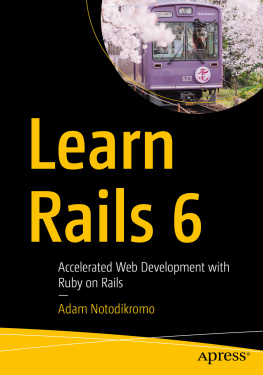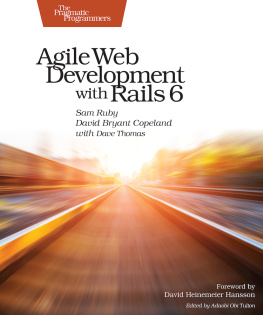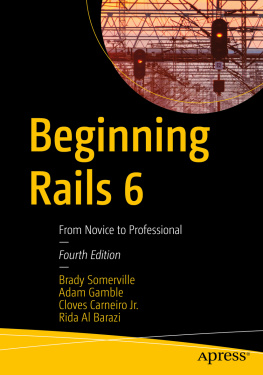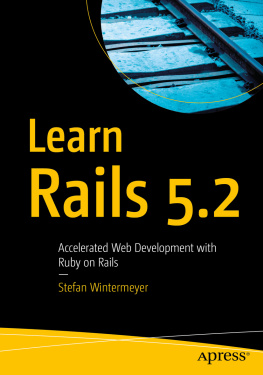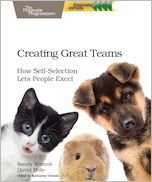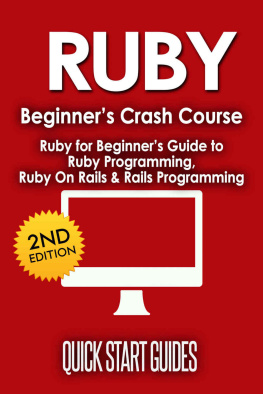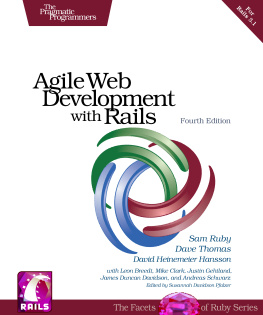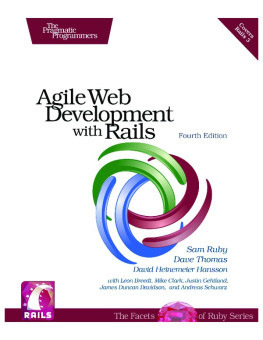Aronowitz - Ruby on Rails: Learn Web Development with Rails , 1st Edition
Here you can read online Aronowitz - Ruby on Rails: Learn Web Development with Rails , 1st Edition full text of the book (entire story) in english for free. Download pdf and epub, get meaning, cover and reviews about this ebook. year: 2020, genre: Computer. Description of the work, (preface) as well as reviews are available. Best literature library LitArk.com created for fans of good reading and offers a wide selection of genres:
Romance novel
Science fiction
Adventure
Detective
Science
History
Home and family
Prose
Art
Politics
Computer
Non-fiction
Religion
Business
Children
Humor
Choose a favorite category and find really read worthwhile books. Enjoy immersion in the world of imagination, feel the emotions of the characters or learn something new for yourself, make an fascinating discovery.

Ruby on Rails: Learn Web Development with Rails , 1st Edition: summary, description and annotation
We offer to read an annotation, description, summary or preface (depends on what the author of the book "Ruby on Rails: Learn Web Development with Rails , 1st Edition" wrote himself). If you haven't found the necessary information about the book — write in the comments, we will try to find it.
Ruby on Rails: Learn Web Development with Rails , 1st Edition — read online for free the complete book (whole text) full work
Below is the text of the book, divided by pages. System saving the place of the last page read, allows you to conveniently read the book "Ruby on Rails: Learn Web Development with Rails , 1st Edition" online for free, without having to search again every time where you left off. Put a bookmark, and you can go to the page where you finished reading at any time.
Font size:
Interval:
Bookmark:
Ruby on Rails
***
The Ultimate Beginner's Guide to Learn Ruby on Rails Step by Step
By Max Beerbohm & Moaml Mohmmed
nd Edition
"Programming isn't about what you know; it's about what you can figure out . - Chris Pine
memlnc
The concept of the framework is to make a set of routine repetitive tasks easy and does not take a lot of time, whether it is in the field of development of sites or programs, etc. It enables you to build modern and sophisticated sites based on the Ruby programming language and uses the same language for background programming.
Rails Framework Features
{ Focus well }
One of the most important features that make developers prefer to build and programming sites using Rails is the speed and ease, so that to create a new project it does not need a lot of things to do where you need a very simple thing, this made it one of the most famous solutions to build powerful sites such as Twitter, which Partly based on Rails at some point, one of the powerful things it offers is the default presets that save the developer a lot of time, and its MVC style makes it an ideal choice for anyone who wants a building site in modern ways.
Of course, since the framework of Rails is based on the programming language Ruby, it means that you will write the site or logical and programming part Back_end using them, and this in itself is something fun as it is one of the easiest and most efficient languages because of the availability of dynamic and powerful.
Learn Ruby
{ You can skip this part (not necessary }
Of course before you start learning the framework must first learn some things from them and of course HTML and CSS and JAVASCRIPT, which enables you to build the interface of the site, also you must be familiar or have already dealt with the language of the Ruby programming language itself where it will be used primarily for programming Back_end as previously Signal.
Another thing is the need to learn to work with MySql databases that will be used primarily with the framework.
{You can skip this part (not necessary)}
To answer this question I will quote the words of the language tuner
quotation
Matsumoto said the Ruby programming language was designed for productivity and fun. He emphasizes that his design any system needs to focus on human needs, rather than a computer,
People often, especially computer engineers, have their focus on the computer. They think, "By doing this, the device will work faster. By doing this, the device will work more effectively. Through it, the device will be and be and be" but really we need to focus on humans and on how to write and understand our software Or apps running on the device. We are gentlemen (humans). They are slaves (organ).
This is evident when you start programming in Ruby, as the programming process may seem to you as if you were conversing with a computer in English (for simplicity).
Of course the Ruby language when it was first introduced (1995) was not famous until the design of the famous framework ruby on rails in 2005, which is one of the most powerful tires
Rails is a web application development framework written in the Ruby programming language. This framework is designed to facilitate web application programming by making some presuppositions about what the developer needs to get started. This framework allows you to write less code and do more than any other programming language or framework.
Rails assumes there is an optimal way to get things done.It was designed to encourage the developer to follow these methods and at times encourage them to leave other alternatives.You may notice a huge increase in your productivity if you learn the method followed by this framework, and may lead to adherence to the old habits of programming languages Other to a poor experience in developing applications using Rails.
{You can skip this part (not necessary)}
Dont Repeat Yourself: This concept states that any part of the knowledge must be represented individually, unambiguously, and reliably in the system. Following this concept in writing scripts and not repeating the same information continuously leads to increased serviceability of the written code and the ability to expand in addition to the low percentage of errors in it.
The principle of Convention Over Configuration: Rails has special principles associated with determining the best way to do business in a web application, and relies on these principles by default rather than forcing the developer to identify small details in his work through a large number of settings.
This series is intended for beginners who want to start building applications on the Rails framework. No previous experience in this area is assumed, but there are a few things to install before you start learning:
- Install Ruby version 2.2.2 or higher.
- Install the appropriate version of the Development Kit if you are a Windows user.
- RubyGems package management system which comes with Ruby by default.
- Install SQLite3 databases.
We have mentioned that the Rails framework is built using Ruby, and if you have no previous experience in this language, you can review the lessons on the basics of Ruby in the Academy as well as the official language site.
The goal of this introduction is to build a simple blog using the Rails framework, and before you start building the app, make sure you have Rails installed on your device.
We will use the $ symbol to express the command line on UNIX-like systems. In Windows, you will see a command line that starts with something similar to this formula:
Go to your computer's command line (on macOS, open Terminal.app, and in Windows choose Run from the Start menu and type cmd.exe). At first we will check the language version of Ruby installed in the device:
$ ruby -v
ruby 2.3.1p112
There are many tools to help install Ruby and Ruby on Rails on your device. Windows users can use the Rails installer, while macOS users can use Tokaido. To learn more about the available installation methods for various operating systems, see the official Ruby website.
SQLite3 databases are usually installed by default on UNIX-like systems. In Windows, if you install Rails through the Rails installer, SQLite will be installed on your computer as well. You can also check the SQLite3 website for database installation instructions. SQLite3 installation can be verified with the following command:
$ sqlite3 --version
If SQLite is installed, the version number will appear on the command line.
On Linux systems you will also need to install the libsqlite3-dev package (in Ubuntu), sqlite-devel (in Fedora).
To install Rails, use the RubyGems gem install command:
$ gem install rails
To make sure that the installation is done correctly, you should be able to execute the following command on the command line:
$ rails --version
You should get a result similar to this: Rails 5.1.0.
The Rails framework provides a set of codes called generators, which are intended to facilitate the work of the developer by creating the files needed to embark on a task. The new app generator is one of these generators and creates a new Rails application and saves the trouble of being written by the developer.
To use the generator, go to the command line to the folder where you want to create the application and type the following command:
$ rails new blog
This will create a new application named Blog in your blog folder and install the gem credentials in GEMfile using the bundle install command.
Next pageFont size:
Interval:
Bookmark:
Similar books «Ruby on Rails: Learn Web Development with Rails , 1st Edition»
Look at similar books to Ruby on Rails: Learn Web Development with Rails , 1st Edition. We have selected literature similar in name and meaning in the hope of providing readers with more options to find new, interesting, not yet read works.
Discussion, reviews of the book Ruby on Rails: Learn Web Development with Rails , 1st Edition and just readers' own opinions. Leave your comments, write what you think about the work, its meaning or the main characters. Specify what exactly you liked and what you didn't like, and why you think so.

